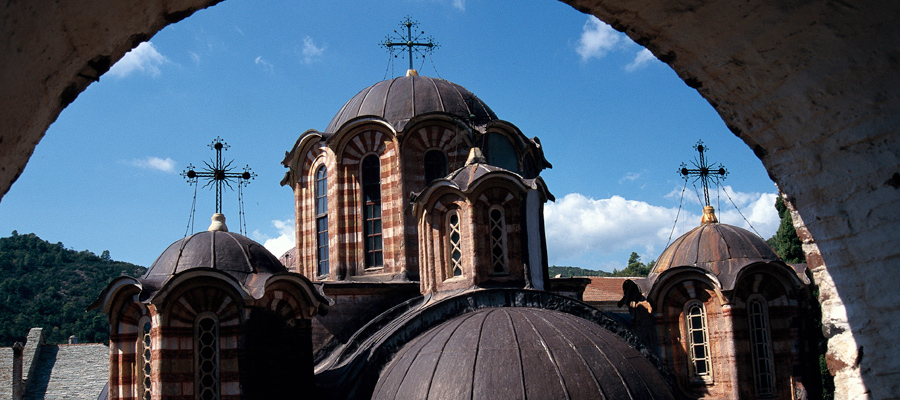Zografou monastery
Built in the northwestern part of Athos peninsula, north of Konstamonitou monastery, is unseen from the sea. The foundation year is wrapped by legend, which says that the ascetics named Moses, Aaron and John from Ohrid settled there in the 10th century during the times of Leo VI the Wise. Another tradition claims that it was named after a picture of St. George that suddenly appeared on a wooden surface after its founders’ dispute. According to researchers, its establishment is connected to the signed name Georgios Zografos appearing in 970-72 on the “Tragos” (typicon) of John Tsimiskes. He is not mentioned as a monk or abbot, he was probably a hagiographer, taking into consideration that monk and abbot Nicholas that co-signatures the document was a calligrapher.
The monastery is mentioned in the Mount Athos summit in 1051. Bulgarian monks undertook its administration since the 13th century. Its archives from the end of the 13th century to 1320 are valuable sources for the agricultural history of the Strimon valley. The cenotaph indicates a sad event: In 1276, when Michael VIII Palaiologos was emperor and Vekkos was Patriarch, monks were tragically killed because they refused the unity with the Roman-Catholic church.
The monastery recovered after the destruction caused by Catalan pirates in the 14th century, with the support of the Palaeologeans, Michael Asen of Bulgaria and abbot Stefanos Kalos (1457-1504), voivode of Moldova who built the tower of the small harbor and gave several dependencies away. Since Bulgarian monks’ prevailed in the monastery in 1845, religious services were forced to be done in Slavonic and ancient Slavic ecclesiastical languages. Up until then, Serbs and Bulgarian monks coexisted, and up until middle 19th century the services were chanted in Greek and Bulgarian languages. In 1801, the Catholicon dedicated to George the Great Martyr, was built on earlier foundations. By tradition, the fraternity honors his divine-made picture in the shrine of the temple. The murals are dated back in 1817 and the church was supplemented with a glass covered narthex. The picture of Virgin “Epakouousa” kept in the Sanctuary is an heirloom of the monks. The library of the monastery contains 126 Greek, 388 Slavic manuscripts and more than 10.000 books.
Text: Dr. Antonios G. Dikaios Theologian – Environmentalist.






